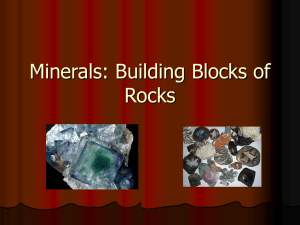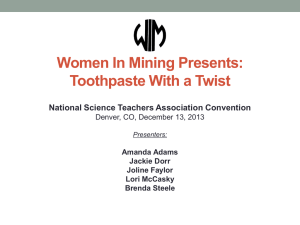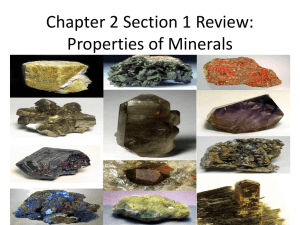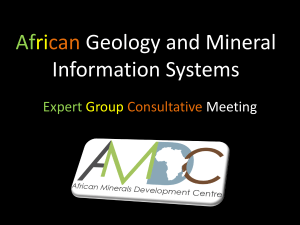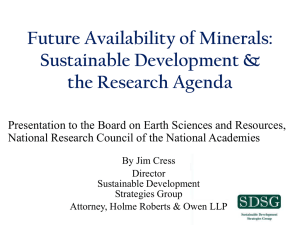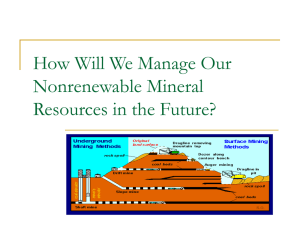MinERALS
advertisement
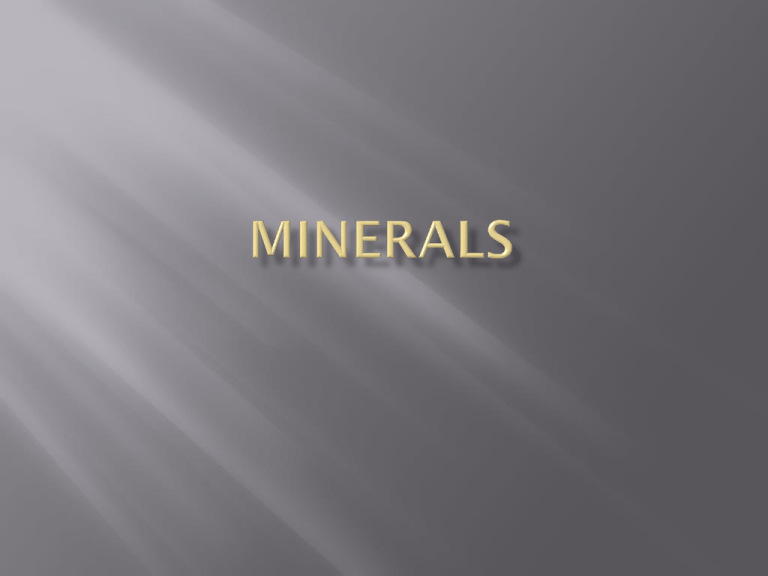
Canada is the third largest producer of minerals. Canada is the worlds largest exporter of minerals. Only the United States and Russia produce more. We export 80% of the minerals we produce. Canada earns roughly $83 billion annually from its mineral resources. A mineral is a naturally occurring, pure, nonliving substance found in the rocks of the earth. There are many minerals that have no economic value, but some are hugely valuable. All minerals are divided into three distinct groups: Fossil Fuels Metallic Minerals Non-Metallic/Industrial Minerals A fossil fuel (non-renewable resource) is any mineral that can be burned to create energy. Fossils fuels are given this name due to the fact that they were formed by dead plants and animals being compressed and heated over millions of years. There are three different fossil fuels the world uses. Natural gas: is a naturally occurring hydrocarbon gas mixture consisting primarily of methane. Crude oil: naturally occurring liquid composed mostly of hydrogen and carbon. Fuel for cars, boats, etc. It is also used for asphalt for roads, lubricants for machines, plastics for toys, bottles, and computers. Coal: is a rock that burns (a solid hydrocarbon), Production of electricity and/or heat, and is also used for industrial purposes such as refining metals. Metallic minerals are minerals that when refined form the group of materials we know as metals. 1. Some of these metals are mined for their beauty and rareness. These are known as precious metals. gold, silver, bronze, platinum and so on. 2. Secondly, metals are mined for their strength such as iron. 3. Finally, other metals are mined for their unique properties. Copper, for example, is mined for its unique quality of being an excellent conductor or electricity Metallic Minerals: Cobalt, copper, gold, iron, nickel, uranium, zinc Silver Iron Gold Copper (wires good conductor for electricity) Often non-metallic minerals are also referred to as industrial minerals. Non-metallic minerals are a more difficult type of mineral to define. Are often described in terms of what they are not. Are all things that are mined that are not metallic minerals or fossil fuels. These are minerals that are not metallic but possess other useful qualities. Each of these minerals has a unique quality that makes them useful. This group of minerals includes: gravel, sand, gypsum, potash, soapstone, salt, asbestos and diamonds. Potash (fertilizer) (Eskimo art) Soapstone Gravel (Fire Proof) Asbestos 1. Nickel 2. Natural Gas 3. Potash 4. Sand 5. Gold 6. Oil 7. Gravel 8. Copper a. Electric Wire b. Glass & Ceramics c. Electronic Contacts d. Fertilizer e. Cement f. Stainless steel g. Heat in your home h. Plastic cd case 1. Nickel 2. Natural Gas 3. Potash 4. Sand 5. Gold c. Stainless steel g. Heat in your homes d. Fertilizer b. Glass and Ceramics c. Electronic Contacts (usb cables, good conductor of electricity) 6. Oil 7. Gravel 8. Copper h. Plastic cd case e. Cement a. Electric Wire Look at the map on Page 319 of your textbook. Jot down on your resource map what type of mineral is mined in each province/territory. Create some sort of legend. There are three major types of mining that are commonly used: Strip Mining Open Pit mining Underground mining Which type of mine is used depends on the location of the mineral deposits. Get into small groups. Use the text book. Pages 324 & 325 Find description and come up with pros and cons of each type of mining. Is used to extract minerals, such as coal and oil sands, that are located in horizontal layers near the surface. 1. Overburden (trees, earth, rock) is removed. 2. Blasting may be necessary for some mineral deposits. 3. Material is loaded onto trucks or conveyor belts by shovels or draglines. 4. Material is taken to storage area for shipment to market or processing. Pros Quicker Cheaper Strip mining areas can be filled in to its natural state, but the process can take up to 30 years Cons The large impact of surface mining on the topography, vegetation, and water resources has made it highly controversial. Is used to extract minerals that are located near the surface but that may extend deep into the earth. 1. Overburden is removed. 2. Holes are drilled 10-15m deep and filled with explosives. The rock is blasted apart. 3. Ore is loaded into large trucks (which may carry 90 to 250 tonnes) by huge shovels. 4. Ore can now be taken to a storage site near the mill. Examples: Adams Mine – abandoned mine in Kirkland Lake Ont. Sherman Mine – abandoned iron mine in Temagami, Ont. Colomac Mine – gold mine in Northwest Territories. Pros Easier extraction Open-pit mines are chosen when deposits of valuable minerals are found beneath the surface and where there overburden (overlaying rock or earth) is relatively thin. Safer working conditions Cave-ins are virtually eliminated as risks; and build-up of toxic gases, which can cause sudden explosions or contribute to chronic illnesses, does not occur. Cons Environmental Contamination negative impact on the surrounding environment and ecosystems. The removal of the overburden destroys the pre-existing landscape and contributes to erosion. Human health risks Tailing ponds are large contained bodies of waste water left behind after mineral extraction and treatment. Contaminated water sits in these ponds, This can result in the contaminants leeching into the soil or local surface and ground water systems. Super pit Gold mine Sherman Mine Is used to extract mineral ores located deep in the earth. 1. Miners take an elevator (cage) from the headframe down to the working area (stope). 2. Holes are drilled in the rock face at the stope and filled with explosives. 3. The explosive is set off by an electric charge. The rock is blasted apart. 4. After the blast, miners test the walls and ceiling. Rock bolts or timber supports are used to prop up week areas. 5. Blasted rock is called “muck.” Front-end loaders or small trains remove the much to a central underground location. The muck is dropped down a large hole (ore pass) to the crusher. 6. The muck is crushed and loaded onto a hoist, called a skip. The skip lifts the ore to the surface. 7. Ore is taken to a storage site near the mill. Pros It allows minerals to be extracted from deep underground. It doesn't create a mess like open cut or surface mining. Does not affect the physical environment as much as surface mining. Cons Costly Unsafe working conditions. Cave-ins, build-up of toxic gases, which can cause sudden explosions or contribute to chronic illnesses. Pollution from tailings ponds Once minerals are mined, they are taken to a smelting factory in order to be separated into its purest form. Due to the fact that not all of the material mined is useful, much of it needs to be disposed of. This waste is called tailings and are composed of water, chemicals and rock particles. Tailings are poisonous and are dumped into tailings ponds that prevent the dangerous chemicals from seeping into lakes and rivers. Unfortunately, many animals cannot tell the difference between tailings ponds and regular ponds and will often land in them. This is extremely detrimental to an animals health. https://www.youtube.com/watch?v=83DpVk -uN00 Negative Impact on the Environment The smelting and refining process in the mining industry is responsible for harmful emissions that find their way into the air and nearby lakes and rivers and can also cause acid rain. There have been several restrictions placed on these factories in an attempt to cut emissions. Unfortunately, these restrictions tend to decrease the production of the plant. Companies need to be as environmentally friendly as possible while still being competitive in a world market. Six of the biggest ten polluters in North America are smelters and refineries in Ontario, Quebec and Manitoba. The largest producer of sulphur dioxide is in Sudbury Ont. Abandoned Mines What happens to the land once a mine is closed? Even after mines are closed they can still continue to pollute the area nearby. Governments now require mining companies to plan what will be done with the mine after it is closed. Many mines are filled with gravel or water and are used for recreation. http://www.youtube.com/watch?v=ynwoYVHx5O8&feature =related&safety_mode=true&persist_safety_mode=1&safe=acti ve Mining Towns Mining towns are completely dependent on the mines for their existence. Once a mine closes, the town will have a very difficult time surviving unless they find another economic opportunity. This can be very disruptive to peoples lives. http://www.youtube.com/watch?v=byxVwec_IaI Mineral Deposits in Other Countries Developing countries do not have nearly as many environmental restrictions as Canada. Ex. Pollution control, only certain amount of pollution aloud or get fined. For this reason the other countries can sell their minerals for cheaper and threaten the Canadian market. Part of operating costs go to being environmentally safe, and other countries don’t follow as close Choose 3 of 5 threats, brainstorm two individuals who might have an opinion on the issue. Write down what their perspective might be. Choose one of the perspectives you have just written about. You must write from that persons perspective. You may choose to write in one of the following forms: Letter Diary Speech Proposal Make sure that you are using the information we have already learned in your response. Use the 5 factors that influence the location of industry in order to make an educated decision on where you are going to open your new manufacturing plant. Your new plant must be dedicated to the production of one of the following products: Wooden Canoe Paddle Leather Purse Gold Necklace Kleenex


